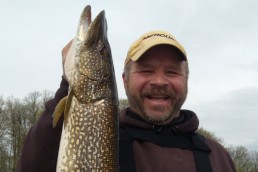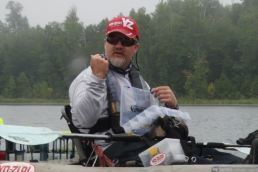Fishing is a Sport of Continual Learning
SHARE THIS POST
Once upon a time, the opening day of fishing season was the only thing that mattered. Being much younger made it so. Then, age mellowed those thoughts. But back in those high school and college years, a bunch of us fished any open water for any species as soon as we could find it. But, like everything fishing is a sport of continual learning.
Growing up in northern Wisconsin meant Lake Superior and Green Bay weren’t that far away. Of course, gas was less than a buck a gallon. The 14-foot boat was easy to tow. Gear was much simpler back then. But we still had a “green box” Fish Lo-K-Tor. Thanks, Dad!
Back then, kids taking a couple-hundred-mile fishing “day trip” was sort of normal—or at least we thought it was normal. Later, after Vietnam, Fate smiled, and I slid into the fishing and marine industry. Traveling to states where seasons never closed allowed me to fish open water all year long. No matter, I was still out with the opening-day crowd.
Some of those early trips stand out much higher than others because of dumb mistakes made. My buddies from back then still remind me whenever they have a beer. Phone calls often start with, “Remember when…”
About age 17, on a trip to Green Bay for ice-out brown trout, we said those infamous words, “Sure, I think we have enough gas for today.” After that episode of limping in after dark and no gas stations, motels or restaurants open in Bailey’s Harbor (and no other fishermen), we slept in the car. After that, we both ventured into our different directions in life, but never, ever, go on the water without a full gas tank.
One guide day on Lake Hubert north of Brainerd, Minn., I readied the boat. I was positive I inserted the drain plug into the correct hole. My clients were anxious to fish. The boat was launched, we idled out and on the first cast, a largemouth chomped. Then, a smallmouth, all less than 200 yards from the launch. A comment about water on the floor of the boat, however, signified a problem. I told them I was going to the dock. Once on the trailer, the water flowed forever. The elder client said, “This will be a good day. I like fishing when exciting things happen.” He later landed his personal best largemouth on a Wacky Worm. Drain plugs in any boat I happen to be in are always checked twice.
Parked at the Cottonwood Motel in Glasgow, Montana, with my boat backed against the building, and the extension cord plugged into the on-board battery charger, I got excited stepping into the fresh November air. The wind was not blowing. It was almost above freezing. My fishing partner and I jumped into the truck and pulled out. About halfway to Fort Peck Reservoir, I asked Daryl Christensen if he’d unplugged the extension cord. He looked at me as if to say, “That’s your job.” When we returned after a very good walleye day, the cord was strung out 100 feet from where I was parked.
On a fishing trip to explore sauger fishing on the Tennessee River, my local friend said jigging was the answer—with either 1- or 1 or 1 ½-ounce jigs. I thought that would be interesting, but still carried a few Northland round-ball jig heads from ¼- to ½-ounce. It so happened that the fish were tight to the riprap, and pitching light jigs was the answer. The lesson was based on Dad telling me to always be ready for the unexpected. And, my high school fishin’ buddy’s dad who always said, “You never know; never know.”
Are you enjoying this post?
You can be among the first to get the latest info on where to go, what to use and how to use it!
Whenever I thought I knew the answer, I was usually wrong. That’s why, whenever with a local expert or professional angler, I did exactly what he or she recommended. The second day was another story. What I learned is that local tactics for one species work wonders for other species in systems far removed.
Fishing walleyes in a Missouri reservoir with a local expert, we were dragging jigs and crawlers in 35 feet of water in spring. “It’s what we always do in summer and fall,” my host explained. He snagged, and I jumped on the trolling motor while he re-tied. I aimed towards shore, and flipped a jig to shore, let it drop, felt it hit a ledge about 12 feet down, twitched it and thump. He got the net and asked, “Why are you in here?” We discussed walleyes in spring and continued to catch them shallow.
Many tactics in common use today—walleyes on plastics, slip-bobbers for everything, muskie gear for big pike, crankbaits for western trout, artificials for panfish year-round, planer boards for crappies, stripers, pike and more—all just a few of the methods that have been exported from one region to another and from one species to many more.
Safety and always having an open mind will pay big dividends this season. If you’re like me, you check out all the new products and even buy a few. The key is to use new lures when the bite is really exploding. I advise guys to first do something they’re not used to—read the manual and watch the video—then head to the water. And, as this year progresses, take somebody on the water who doesn’t have the opportunity, especially kids.
Become a MidWest Outdoors Insider here!
MWO
SHARE THIS POST
You may also like...
Did you enjoy this post?
You can be among the first to get the latest info on where to go, what to use and how to use it!
Jim Kalkofen
Jim Kalkofen grew up with a fishing rod in his hands. After years in the PR game for Mercury and Mepps, he directed the Professional Walleye Trail. He and partners Al and Ron Lindner now provide weekly walleye and ice-fishing education and entertainment in Target Walleye/Ice, a free subscription email (targetwalleye.com). For more info: jim@targetwalleye.com or 651-356-5676.


